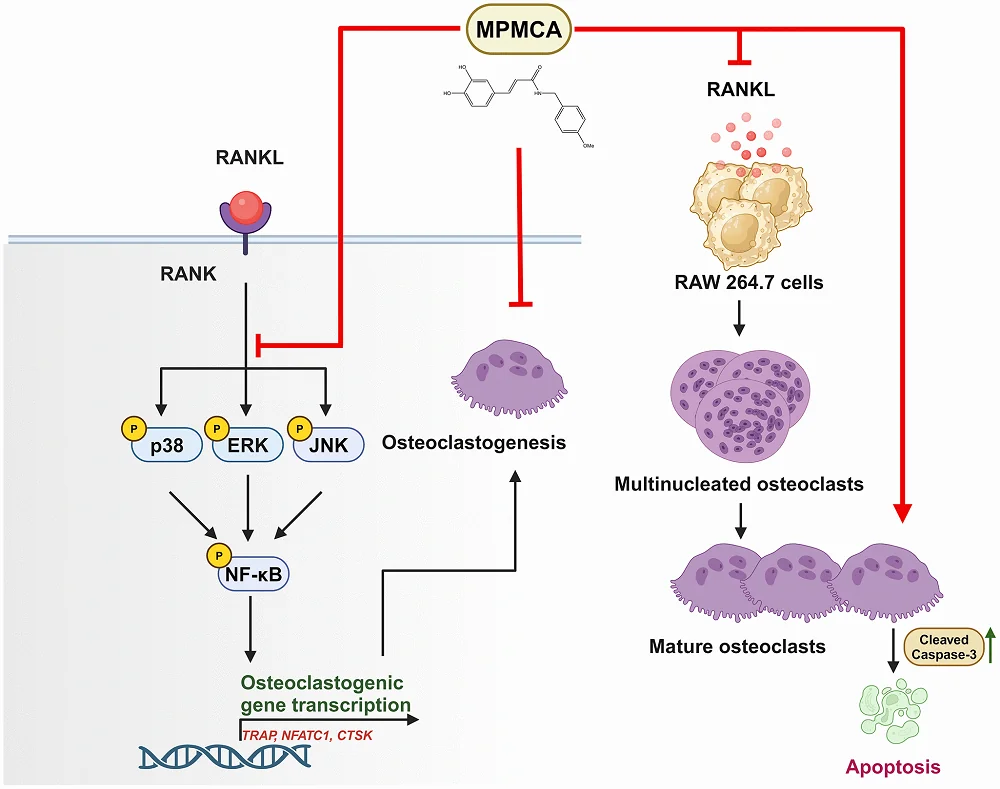In Aging, researchers have described how a derivative of caffeic acid inhibits osteoclasts, the cells that break down bone.
A modification of a tested compound
We have recently published new information on what triggers the imbalance between bone-destroying osteoclasts and bone-building osteoblasts. This is a well-known problem with aging, and researchers around the world have looked into ways of rectifying this imbalance. Caffeic acid, which is found in coffee, tea, fruits, vegetables, and some extracts, has, among other positive effects, been previously found to suppress osteoclasts [1], including in a rat study [2].
These researchers have previously modified caffeic acid into N-(4-methoxyphen) methyl caffeamide (MPMCA), a compound that they have found to be more effective than regular caffeic acid in protecting the liver against oxidative stress [3]. Therefore, they conducted this study in order to determine if it could also be more effective in suppressing osteoclast activity.
Broad effects against precursors and mature cells
Interestingly, MPMCA does not inhibit osteoclast precursors under normal circumstances at any of the tested doses, from 0.1 to 3 μM. However, when these precursors are stimulated to become osteoclasts through the RANKL pathway for seven days, MPMCA reduces the number of osteoclasts, markedly reduces their average size, and suppresses the production of F-actin, which is required for differentiated osteoclasts to attach to bone. These effects are dose-dependent.
Gene expression analysis confirmed these findings. The genes TRAP, CTSK, and NFATC1, all of which are related to osteoclast differentiation, were suppressed by MPMCA. Testing at higher doses, the researchers found that MAP kinase pathways were similarly suppressed, as was the well-known NF-κB pathway.
MPMCA also encouraged differentiated osteoclasts to die by apoptosis. Cleaved caspase-3 and DAP, both of which are apoptosis markers, were increased with MPMCA. Just like with precursors, both the number and size of these mature osteoclasts were reduced.

However, MPMCA, unlike caffeic acid [2], did nothing to osteoblasts. Osteoblast differentiation markers, including gene expression, were unaffected.
These findings are very positive, but they were only in cells. If the results of this study can be replicated, and this compound can be confirmed to be safe and effective in animal models, MPMCA may be a candidate for clinical trials against osteoporosis and age-related bone loss.
Literature
[1] Ekeuku, S. O., Pang, K. L., & Chin, K. Y. (2021). Effects of caffeic acid and its derivatives on bone: A systematic review. Drug design, development and therapy, 259-275.
[2] Tang, Q. Y., Kukita, T., Ushijima, Y., Kukita, A., Nagata, K., Sandra, F., … & Iijima, T. (2006). Regulation of osteoclastogenesis by Simon extracts composed of caffeic acid and related compounds: successful suppression of bone destruction accompanied with adjuvant-induced arthritis in rats. Histochemistry and cell biology, 125, 215-225.
[3] Tsai, T. H., Yu, C. H., Chang, Y. P., Lin, Y. T., Huang, C. J., Kuo, Y. H., & Tsai, P. J. (2017). Protective effect of caffeic acid derivatives on tert-butyl hydroperoxide-induced oxidative hepato-toxicity and mitochondrial dysfunction in HepG2 cells. Molecules, 22(5), 702.







